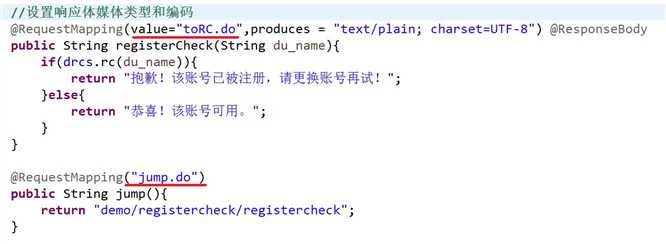标签:ati 格式化 jaxb code 服务器端 from tin UI title
前段时间项目中用到了REST风格来开发程序,但是当用POST、PUT模式提交数据时,发现服务器端接受不到提交的数据(服务器端参数绑定没有加任何注解),查看了提交方式为application/json, 而且服务器端通过request.getReader() 打出的数据里确实存在浏览器提交的数据。为了找出原因,便对参数绑定(@RequestParam、 @RequestBody、 @RequestHeader 、 @PathVariable)进行了研究,同时也看了一下HttpMessageConverter的相关内容,在此一并总结。
@RequestMapping
RequestMapping是一个用来处理请求地址映射的注解,可用于类或方法上。用于类上,表示类中的所有响应请求的方法都是以该地址作为父路径。
RequestMapping注解有六个属性,下面我们把她分成三类进行说明。
value: 指定请求的实际地址,指定的地址可以是URI Template 模式(后面将会说明);
当之设置value一个属性时,value可以省略不写,当有其他属性时则需要加上进行区分,如下图:

method: 指定请求的method类型, GET、POST、PUT、DELETE等;
consumes: 指定处理请求的提交内容类型(Content-Type),例如application/json, text/html;
produces: 指定返回的内容类型,仅当request请求头中的(Accept)类型中包含该指定类型才返回;
params: 指定request中必须包含某些参数值是,才让该方法处理。
headers: 指定request中必须包含某些指定的header值,才能让该方法处理请求。
默认RequestMapping("....str...")即为value的值;
1 @Controller 2 @RequestMapping("/appointments") 3 public class AppointmentsController { 4 5 private final AppointmentBook appointmentBook; 6 7 @Autowired 8 public AppointmentsController(AppointmentBook appointmentBook) { 9 this.appointmentBook = appointmentBook; 10 } 11 12 @RequestMapping(method = RequestMethod.GET) 13 public Map<String, Appointment> get() { 14 return appointmentBook.getAppointmentsForToday(); 15 } 16 17 @RequestMapping(value="/{day}", method = RequestMethod.GET) 18 public Map<String, Appointment> getForDay(@PathVariable @DateTimeFormat(iso=ISO.DATE) Date day, Model model) { 19 return appointmentBook.getAppointmentsForDay(day); 20 } 21 22 @RequestMapping(value="/new", method = RequestMethod.GET) 23 public AppointmentForm getNewForm() { 24 return new AppointmentForm(); 25 } 26 27 @RequestMapping(method = RequestMethod.POST) 28 public String add(@Valid AppointmentForm appointment, BindingResult result) { 29 if (result.hasErrors()) { 30 return "appointments/new"; 31 } 32 appointmentBook.addAppointment(appointment); 33 return "redirect:/appointments"; 34 } 35 }
value的uri值为以下三类:
A) 可以指定为普通的具体值;
B) 可以指定为含有某变量的一类值(URI Template Patterns with Path Variables);
C) 可以指定为含正则表达式的一类值( URI Template Patterns with Regular Expressions);
example B)
1 @RequestMapping(value="/owners/{ownerId}", method=RequestMethod.GET) 2 public String findOwner(@PathVariable String ownerId, Model model) { 3 Owner owner = ownerService.findOwner(ownerId); 4 model.addAttribute("owner", owner); 5 return "displayOwner"; 6 }
example C)
1 @RequestMapping("/spring-web/{symbolicName:[a-z-]+}-{version:\d\.\d\.\d}.{extension:\.[a-z]}") 2 public void handle(@PathVariable String version, @PathVariable String extension) { 3 // ... 4 } 5 }
cousumes的样例:
1 @Controller 2 @RequestMapping(value = "/pets", method = RequestMethod.POST, consumes="application/json") 3 public void addPet(@RequestBody Pet pet, Model model) { 4 // implementation omitted 5 }
方法仅处理request Content-Type为“application/json”类型的请求。
produces的样例:
1 @Controller 2 @RequestMapping(value = "/pets/{petId}", method = RequestMethod.GET, produces="application/json") 3 @ResponseBody 4 public Pet getPet(@PathVariable String petId, Model model) { 5 // implementation omitted 6 }
方法仅处理request请求中Accept头中包含了"application/json"的请求,同时暗示了返回的内容类型为application/json;
params的样例:
1 @Controller 2 @RequestMapping("/owners/{ownerId}") 3 public class RelativePathUriTemplateController { 4 5 @RequestMapping(value = "/pets/{petId}", method = RequestMethod.GET, params="myParam=myValue") 6 public void findPet(@PathVariable String ownerId, @PathVariable String petId, Model model) { 7 // implementation omitted 8 } 9 }
仅处理请求中包含了名为“myParam”,值为“myValue”的请求;
headers的样例:
1 @Controller 2 @RequestMapping("/owners/{ownerId}") 3 public class RelativePathUriTemplateController { 4 5 @RequestMapping(value = "/pets", method = RequestMethod.GET, headers="Referer=http://www.ifeng.com/") 6 public void findPet(@PathVariable String ownerId, @PathVariable String petId, Model model) { 7 // implementation omitted 8 } 9 }
仅处理request的header中包含了指定“Refer”请求头和对应值为“http://www.ifeng.com/”的请求;
handler method 参数绑定常用的注解,我们根据他们处理的Request的不同内容部分分为四类:(主要讲解常用类型)
A、处理requet uri 部分(这里指uri template中variable,不含queryString部分)的注解: @PathVariable;
B、处理request header部分的注解: @RequestHeader, @CookieValue;
C、处理request body部分的注解:@RequestParam, @RequestBody;
D、处理attribute类型是注解: @SessionAttributes, @ModelAttribute;
当使用@RequestMapping URI template 样式映射时, 即 someUrl/{paramId}, 这时的paramId可通过 @Pathvariable注解绑定它传过来的值到方法的参数上。
示例代码:
上面代码把URI template 中变量 ownerId的值和petId的值,绑定到方法的参数上。若方法参数名称和需要绑定的uri template中变量名称不一致,需要在@PathVariable("name")指定uri template中的名称。
@RequestHeader 注解,可以把Request请求header部分的值绑定到方法的参数上。
示例代码:
这是一个Request 的header部分:
上面的代码,把request header部分的 Accept-Encoding的值,绑定到参数encoding上了, Keep-Alive header的值绑定到参数keepAlive上。
@CookieValue 可以把Request header中关于cookie的值绑定到方法的参数上。
例如有如下Cookie值:
参数绑定的代码:
即把JSESSIONID的值绑定到参数cookie上。
@RequestParam
A) 常用来处理简单类型的绑定,通过Request.getParameter() 获取的String可直接转换为简单类型的情况( String--> 简单类型的转换操作由ConversionService配置的转换器来完成);因为使用request.getParameter()方式获取参数,所以可以处理get 方式中queryString的值,也可以处理post方式中 body data的值;
B)用来处理Content-Type: 为 application/x-www-form-urlencoded编码的内容,提交方式GET、POST;
C) 该注解有两个属性: value、required; value用来指定要传入值的id名称,required用来指示参数是否必须绑定;
示例代码:
@RequestBody
该注解常用来处理Content-Type: 不是application/x-www-form-urlencoded编码的内容,例如application/json, application/xml等;
它是通过使用HandlerAdapter 配置的HttpMessageConverters来解析post data body,然后绑定到相应的bean上的。
因为配置有FormHttpMessageConverter,所以也可以用来处理 application/x-www-form-urlencoded的内容,处理完的结果放在一个MultiValueMap<String, String>里,这种情况在某些特殊需求下使用,详情查看FormHttpMessageConverter api;
示例代码:
@SessionAttributes:
该注解用来绑定HttpSession中的attribute对象的值,便于在方法中的参数里使用。
该注解有value、types两个属性,可以通过名字和类型指定要使用的attribute 对象;
示例代码:
@ModelAttribute
该注解有两个用法,一个是用于方法上,一个是用于参数上;
用于方法上时: 通常用来在处理@RequestMapping之前,为请求绑定需要从后台查询的model;
用于参数上时: 用来通过名称对应,把相应名称的值绑定到注解的参数bean上;要绑定的值来源于:
A) @SessionAttributes 启用的attribute 对象上;
B) @ModelAttribute 用于方法上时指定的model对象;
C) 上述两种情况都没有时,new一个需要绑定的bean对象,然后把request中按名称对应的方式把值绑定到bean中。
用到方法上@ModelAttribute的示例代码:
这种方式实际的效果就是在调用@RequestMapping的方法之前,为request对象的model里put(“account”, Account);
用在参数上的@ModelAttribute示例代码:
首先查询 @SessionAttributes有无绑定的Pet对象,若没有则查询@ModelAttribute方法层面上是否绑定了Pet对象,若没有则将URI template中的值按对应的名称绑定到Pet对象的各属性上。
作用:
i) 该注解用于读取Request请求的body部分数据,使用系统默认配置的HttpMessageConverter进行解析,然后把相应的数据绑定到要返回的对象上;
ii) 再把HttpMessageConverter返回的对象数据绑定到 controller中方法的参数上。
使用时机:
A) GET、POST方式提时, 根据request header Content-Type的值来判断:
B) PUT方式提交时, 根据request header Content-Type的值来判断:
说明:request的body部分的数据编码格式由header部分的Content-Type指定;
作用:
该注解用于将Controller的方法返回的对象,通过适当的HttpMessageConverter转换为指定格式后,写入到Response对象的body数据区。
使用时机:
返回的数据不是html标签的页面,而是其他某种格式的数据时(如json、xml等)使用;
该接口定义了四个方法,分别是读取数据时的 canRead(), read() 和 写入数据时的canWrite(), write()方法。
在使用 <mvc:annotation-driven />标签配置时,默认配置了RequestMappingHandlerAdapter(注意是RequestMappingHandlerAdapter不是AnnotationMethodHandlerAdapter,详情查看spring 3.1 document “16.14 Configuring Spring MVC”章节),并为他配置了一下默认的HttpMessageConverter:
ByteArrayHttpMessageConverter: 负责读取二进制格式的数据和写出二进制格式的数据;
StringHttpMessageConverter: 负责读取字符串格式的数据和写出二进制格式的数据;
ResourceHttpMessageConverter:负责读取资源文件和写出资源文件数据;
FormHttpMessageConverter: 负责读取form提交的数据(能读取的数据格式为 application/x-www-form-urlencoded,不能读取multipart/form-data格式数据);负责写入application/x-www-from-urlencoded和multipart/form-data格式的数据;
MappingJacksonHttpMessageConverter: 负责读取和写入json格式的数据;
SouceHttpMessageConverter: 负责读取和写入 xml 中javax.xml.transform.Source定义的数据;
Jaxb2RootElementHttpMessageConverter: 负责读取和写入xml 标签格式的数据;
AtomFeedHttpMessageConverter: 负责读取和写入Atom格式的数据;
RssChannelHttpMessageConverter: 负责读取和写入RSS格式的数据;
当使用@RequestBody和@ResponseBody注解时,RequestMappingHandlerAdapter就使用它们来进行读取或者写入相应格式的数据。
@RequestBody注解时: 根据Request对象header部分的Content-Type类型,逐一匹配合适的HttpMessageConverter来读取数据;
spring 3.1源代码如下:
@ResponseBody注解时: 根据Request对象header部分的Accept属性(逗号分隔),逐一按accept中的类型,去遍历找到能处理的HttpMessageConverter;
源代码如下:
MappingJacksonHttpMessageConverter 调用了 objectMapper.writeValue(OutputStream stream, Object)方法,使用@ResponseBody注解返回的对象就传入Object参数内。若返回的对象为已经格式化好的json串时,不使用@RequestBody注解,而应该这样处理:
1、response.setContentType("application/json; charset=UTF-8");
2、response.getWriter().print(jsonStr);
直接输出到body区,然后的视图为void。
标签:ati 格式化 jaxb code 服务器端 from tin UI title
原文地址:http://www.cnblogs.com/FrankLei/p/6579843.html